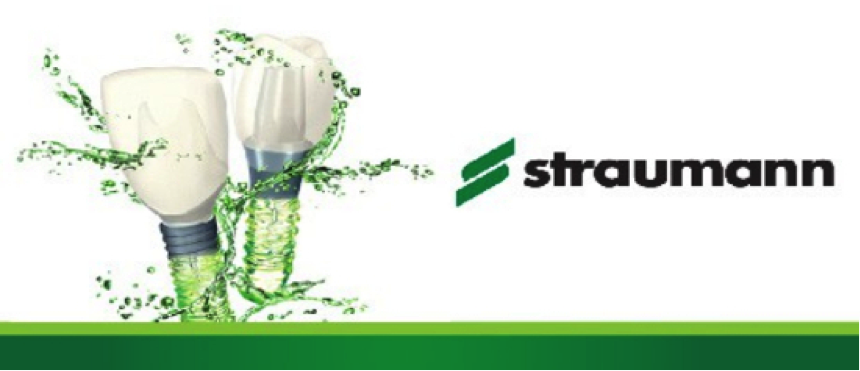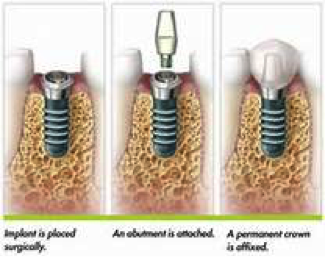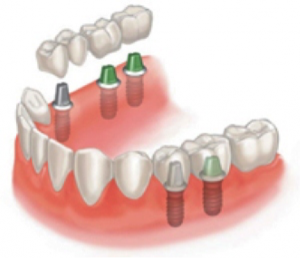DENTAL IMPLANTS
A dental implant is an ideal tooth restoration for people who are missing one or more teeth as a result of injury, periodontal disease, or any other reason. A dental implant is a post that a periodontist or oral surgeon places into the jaw. Once in place and bone surrounding the implant has had time to heal, a replacement tooth is attached to the post. Implants are the best option to replacing your missing teeth other than your own natural dentition.
A lot can be done with dental implants. They can replace an individual tooth or several of them can be used to support a fixed or removable prosthesis.


Please click here for more information.
http://www.straumann.us/en/home.html
Let us help you achieve a healthy, more confident and functional smile that will support your quality of living.




CROWNS AND BRIDGES
Crowns and bridges are used to restore and enhance teeth that are damaged or to take the place of missing teeth. A crown (also referred to as a cap) is used to entirely cover a damaged tooth. A crown not only strengthens a tooth, but it can dramatically improve a tooth’s appearance, shape and alignment.
Crowns may be used to:
- Replace a large filling when there is little tooth structure remaining
- Protect a weak tooth from fracturing
- Restore a fractured tooth
- Attach a bridge
- Cover a dental implant
- Cover a discolored or poorly shaped tooth
- Cover a tooth that has had root canal treatment
A bridge is an ideal method to fill the space created by missing teeth. A bridge is one or more artificial teeth cemented into place using the teeth on either side for support. This is an option for filling the space created by a missing tooth. Bridge work is as much an art as it is an exact science since it replaces a missing tooth both functionally and cosmetically. The materials used may be gold alloys, porcelain bonded to metal alloy, or all ceramic material made to match your natural tooth color. The choice of material depends on requirements for strength, wear, and aesthetics.
It is important that a missing tooth be replaced as soon as possible. If not treated, the teeth surrounding the gap begin to shift inward. Since teeth use their neighbors for support, if one is missing they begin to “fall” and shift into the open spaces. This may worsen the bite because of the changes in pressure and can eventually result in problems with the jaw such as TMJ.
Bridges and crowns are made by first taking an impression of your mouth. The impression is sent to a dental lab where your crown or bridge will be custom made to fit your mouth and match your natural tooth color. A temporary crown or bridge will be placed into your mouth until your permanent crown or bridge is ready and cemented into place.
Bridges and crowns are very durable and can last a lifetime with extra care and good oral hygiene.
TOOTH EXTRACTIONS
Good oral hygiene should always be practiced since the loss of a single tooth can have major impact upon your oral health and appearance. Although dentists will use every measure to prevent tooth loss, there still sometimes necessary occasions when a tooth may need to be extracted. A tooth may need to be extracted for the following reasons:
- Severe decay
- Advanced periodontal disease
- Infection or abscess
- Orthodontic correction
- Malpositioned teeth
- Fractured teeth or roots
- Impacted teeth
After careful examination and treatment, the dentist may advise to have a tooth extracted. Before a tooth is removed, the dentist will take an x-ray in order to understand the shape and position of the tooth and surrounding bone. Based on the degree of difficulty, we may refer you to a specialized oral surgeon.
For a simple extraction, we will first apply a local anesthetic to prevent pain and discomfort. The tooth will be loosened with a tool called an elevator and then removed with dental forceps. Once the procedure is complete, the area may be closed with one or two stitches. We will then provide you with care instructions to alleviate discomfort and ensure proper healing.
ROOT CANAL TREATMENT
Root canal treatment (also referred to as root canal therapy or endodontic therapy) is made necessary when an untreated cavity reaches all the way to this pulp. Treatment may also be needed when deep restorations or trauma to a tooth cause nerve damage. Once the pulp becomes infected, and can begin to eat away at the surrounding bone (this is known as an abscess). If the pulp is infected, not only is it painful but it will require treatment as it cannot heal on it’s own. Symptoms that indicate the pulp has become infected may include sensitivity to hot/cold or sweets, pain, swelling, pain to biting or pressure, and a bad taste in the mouth. However, sometimes no symptoms are apparent and you may be unaware of any problem until a checkup.
A root canal is performed to clean out the infected tooth pulp and disinfect the canals of the tooth. Alternate treatment would be to extract the tooth. Once the infection is resolved, the canal is filled in to prevent any further infection. Usually a core build-up and crown is recommended for restoring a tooth that has undergone root canal therapy.
DENTURES
A denture is a removable replacement for missing teeth and surrounding tissues. There are two types of dentures available, including partial and complete dentures. Partial dentures are used when some natural teeth remain, while complete dentures are used to completely replace all teeth. Dentures are made to resemble your natural teeth so there should be no noticeable change to your appearance. In fact, dentures may even improve your smile!
This restoration method is used to restore your smile and mouth function if all your teeth have been lost. The dentures are custom created to resemble natural teeth and are positioned to take the place of natural teeth. Complete dentures are removable and may require adjustments in order to create a proper fit with the gums and mouth.
A removable partial denture is a device used when one or more natural teeth still remain in the upper or lower jaw. They usually consist of replacement teeth attached go a gum-colored plastic base which is held in place in the mouth. A fixed partial denture acts the same as a removable denture, but it is cemented into place using adjacent teeth for support.
New dentures may feel awkward or loose for the first few weeks until the muscles of your cheek and tongue learn to keep them in place and you are comfortable eating and speaking. Although this may require some practice you will adjust and enjoy the benefits a full mouth of teeth can provide.
TEMPORAL MANDIBULAR JOINT DISORDERS
There is no single cause of TMJ dysfunction. Some of the contributing factors could be:
- Stress and anxiety (leading cause)
- Trauma to the head, neck, or face
- Trauma to the TMJ joint or arthritis
- Hormonal changes or imbalances
- Malocclusion (where the jaws do not line up correctly resulting in bite problems
As with the causes, symptoms of TMJ disorder vary significantly among patients. TMJ symptoms often mask themselves or are similar to those of other medical conditions, making diagnosis extremely difficult. Common symptoms of TMJ disorder include:
- Headaches
- Shoulder, neck, facial pain
- Clicking or popping when opening or closing jaw
- Locked jaw or limited mobility in the jaw joint
- Teeth clenching, teeth grinding, often accompanied by tooth wear
- Chronic earaches
The Dental Arts Center team is experienced in diagnosing and treating TMJ disorders which consider how your bite fits together and how that relationship contributes to problems like headaches, earaches and tooth wear. We offer an affordable sleep study to be done in the comfort of your home, which gives tangible data to treat your symptoms properly.
